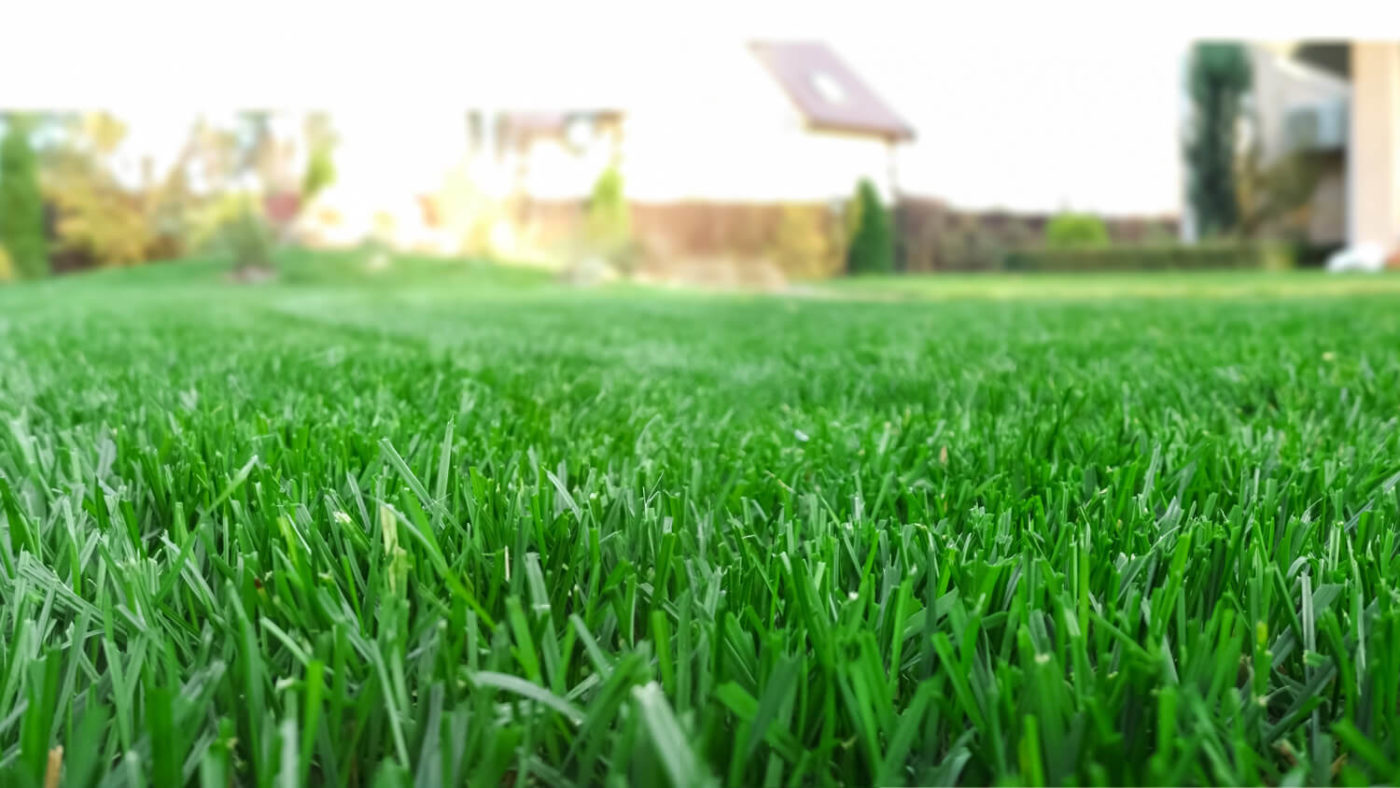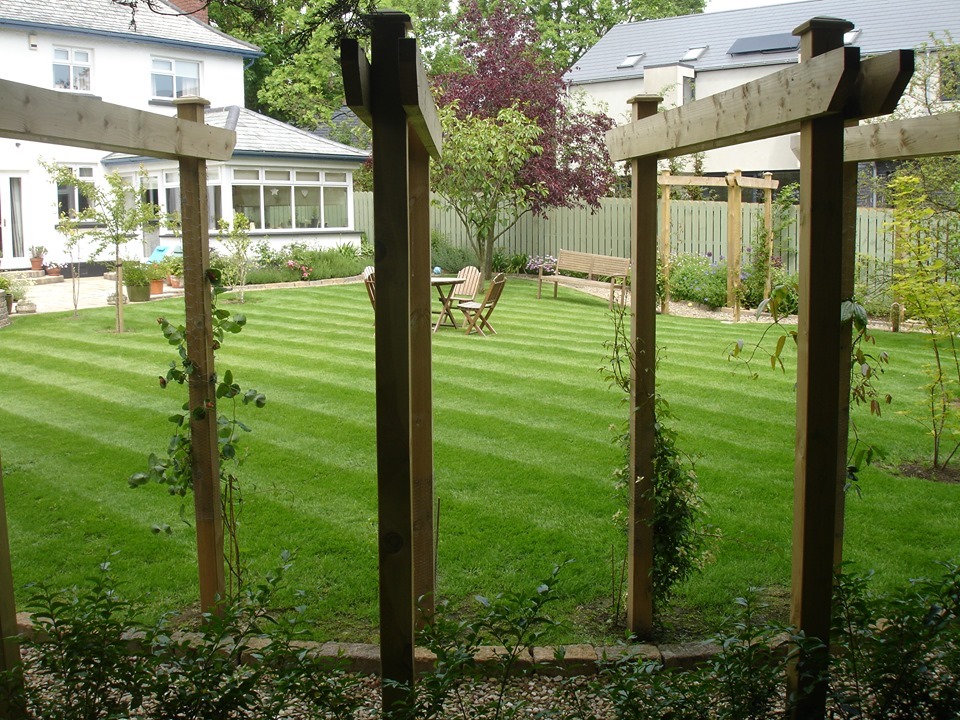Worried that your lawn is turning yellow? Robbie from Premier Lawns helps you to diagnose the problem and fix it.
Why do lawns turn yellow?
Yellow leaves is a sure sign of stress in a lawn, but the reason is not always obvious. There are several possible causes of yellowing leaves, so let’s take a look at the most common problems and how to fix them.
- Water logging
- Soil compaction
- Scalping or blunt mower blades
- Chemical or fertiliser “accidents”
- Nutrient deficiencies
- Pests
- Diseases
Troubleshooting tips
There are so many reasons for a lawn turning yellow that you can drive yourself mad researching the problem.
As the first stage in your diagnosis, ask yourself these questions, hopefully they’ll help you find the culprit whether it be mechanical, accidental, biological, chemical or nutritional.
- How is the yellowing distributed? Is the whole lawn affected? One large patch? Or several smaller spots? If your lawn is spotty, are the areas circular or are they irregular shapes? (Angular shapes often indicate buried bricks – especially in a new build property)
- Is the soil beneath your lawn unusually soggy? Has the weather been unusually wet lately? Are there any downpipes discharging into your garden? Could there be a burst pipe nearby?
- Could your lawn be affected by shade? Either from overhanging trees or nearby buildings? Have toys, picnic rugs or furniture been left on the lawn for more than 24 hours at a time?
- Are your mower blades at the correct height for the grass species in your lawn?
- Has your lawn been fed lately? Have you applied any herbicides or pesticides? Was there a frost soon after the application?
- If you grab a handful of grass and tug it – do the plants come up easily? Do the roots look healthy?
- Are you noticing any unusual activity around your garden? Visiting wildlife? Are the birds extra busy on your lawn? That could be an indicator for leather jackets or chafer bugs.
- Look at the blades of grass – are they yellow all over? Is the discolouration just at the tip of the leaves? Are there spots? Are the veins green?

Every gardener aspires to a beautiful green lawn.
Waterlogged lawns will turn yellow
I’m writing this as a storm rages outside and I know that some of the clay soils in this area will be struggling to cope with the deluge. Waterlogging occurs when rainwater – or runoff from a leaky pipe just cannot escape from the soil fast enough.
We know, that soil is incredibly absorbent… it’s one of Mother Nature’s best inventions. But there comes a point when it just can’t soak up any more liquid. In an ideal world, water filters through the soil, through the bedrock and away into streams and rivers. Sometimes though, there’s a bit of an overload which leads to a backlog.
Why does that make the lawn turn yellow? The reason that soil is so absorbent is that there are trillions of tiny air pockets between the particles. These double up as water channels. BUT here’s the thing. Plant roots need water AND air. If all of the spaces within the soil are filled with water, the roots don’t have a source of oxygen. They start to suffocate and then struggle to provide the rest of the plant with nutrients. The result – leaves are undernourished and lose their colour – just as starving people look pale.
How to combat water logging in lawns
Make sure that your lawn care program includes scarification and aeration – these two techniques used regularly will optimise the drainage on your lawn.
If severe waterlogging happens often in your garden – it’s worth investing in the services of a really good landscaper to get the drainage sorted out.
For emergency first aid to cope with temporary water logging – perhaps after a very wet winter – the number one rule is to keep off the lawn as much as possible until the water has dispersed. Having said that, if the plants are really stressed, there are some techniques that you can use to help the water drain faster.
Watch my video on DIY aerators – for a water logged lawn I’d recommend using either a garden fork or the garden auger – these go much deeper than the spikey sandals. Order your garden auger drill bit here
Soil compaction
Soil compaction is quite possibly the lawn lover’s number one enemy. On very tightly compacted lawns, the roots struggle to push their way deep into the soil and they simply cannot grow. Add to that the fact that water and air – the two most important life forces – cannot circulate in compacted soil and you have a recipe for stressed grass plants.
How will you know if your soil is compacted? Try pushing a 15cm screwdriver into your lawn. It should go in as easily as a hot knife through butter. If not – your lawn has some degree of compaction. The harder you need to push, the bigger the problem.
Compaction may not affect your whole lawn. Did your initial investigation suggest a well trodden path, an area around children’s play equipment or – and this is not as uncommon as you might think – buried objects just beneath the soil surface.
First investigate and remove any buried bricks, rubble etc and then treat the whole lawn to an aeration session. Either hire an aerator from your local tool hire merchant, or, ask a lawn care professional to quote for the work.
A word about mowing
Grass plants need their leaves to harvest energy from the sun. Different species have different requirements for sunlight. A ryegrass lawn will be very happy if it is maintained shorter than around 2cm whereas a fescue lawn can tolerate close mowing.
Apply a seaweed tonic and raise your mower blades to see if the grass recovers.
Allowing your lawn to grow long and then suddenly cutting it very short will shock the grass plants and they may temporarily turn yellow. Stick to the one third rule and reduce the height of long grass gradually if you want your lawn to stay green.
Keep those mower blades sharp. You want to be making a clean cut. Ripping the tips off your grass blades leaves nasty open wounds that can become infected with disease.
Chemical or fertiliser accidents
Could you have accidentally spilt anything on your lawn? Maybe the petrol overflowed when you were filling up your mower? – or a bit of fertiliser missed the tank on your spreader? Small spillages often rectify themselves. For a small area, use water with a little washing up liquid in it to try to flush the culprits through the soil. Alternatively dig the area out, removing as much soil as possible then bring in fresh topsoil and re-seed the patch.
Miscalculating the amount of feed or chemical you apply to your lawn can result in yellowing. As can treating your lawn just before a frost. Talk to a lawn care expert before taking any remedial action – let them know exactly what was applied, how much and when. Don’t be embarrassed – everyone gets caught out sometimes.

Could your yellow lawn be hungry?
Certain nutrient deficiencies will affect the colour of your lawn. Does your lawn fertiliser contain micro-nutrients (minerals) as well as nitrogen, phosphorus and potassium?
Is the soil beneath your lawn making nutrients available to your plants? Some soils, particularly very acidic or very alkaline soils, react with the chemical elements of plant nutrients and effectively lock them away so that the roots cannot absorb them. Read my blog about Humic Acid to find out how to improve the soil. https://premierlawns.co.uk/how-humic-acid-can-improve-your-lawn/
Some of the budget feeds don’t supply the full range of nutrients for you lawn. Deficiencies will show up as pale areas between the veins.
For a quick fix, apply a foliar seaweed treatment ASAP, better still, contact a reputable lawn care company who will be able to advise on the optimum nutrition for your lawn.
Common lawn pests
If large areas of your lawn look yellow, the plants are easy to pull up and you are noticing extra activity from the birds – you may well have leatherjackets or chafer grubs munching their way through the roots of your grass.
Take a garden spade and carefully lift a piece of turf. If you have a pest infestation you’ll see them. Leatherjackets are 2-3 cm long, a dark brown colour and quite ugly. Chafer grubs look like big fat maggots. They are white with brown heads and usually curled up into a ‘C’ shape.
Annoyingly, there are no chemical controls for chafer grubs or leather jackets. But here’s a little trick that works well.
Water your lawn thoroughly – really drench it. Immediately afterwards, cover the affected area with a sheet of black plastic. Peg it down and leave it overnight. In the morning, the critters will have risen to the surface. You can sweep them up with a springtime rake and dispose of them, OR you can crush them – depending on how squeamish you are.
Once the creatures have either been removed, or they’ve hatched into may bugs and crane flies – you can do some lawn renovations. Scarifying to remove weak grasses then aerating, topdressing and overseeding.
Make a note in your diary to treat your lawn with nematodes next September – these need to be applied when the soil is warm and the lavea are miniscule.
More lawn pest information in this article.
Lawn diseases
Discoloured leaves is usually one of the first signs that your lawn has been affected by disease. Don’t worry, most of them are quite manageable with good hygiene, careful nutrition and a pinch of patience. Read my blog on common lawn diseases such as fusarium patch and redthread.
A yellow lawn is never attractive, but once you find the cause, it is usually easily remedied.
If you want to learn more about lawn care and how to avoid yellowing, subscribe to the Premier Lawns YouTube Channel for up to the minute advice.

